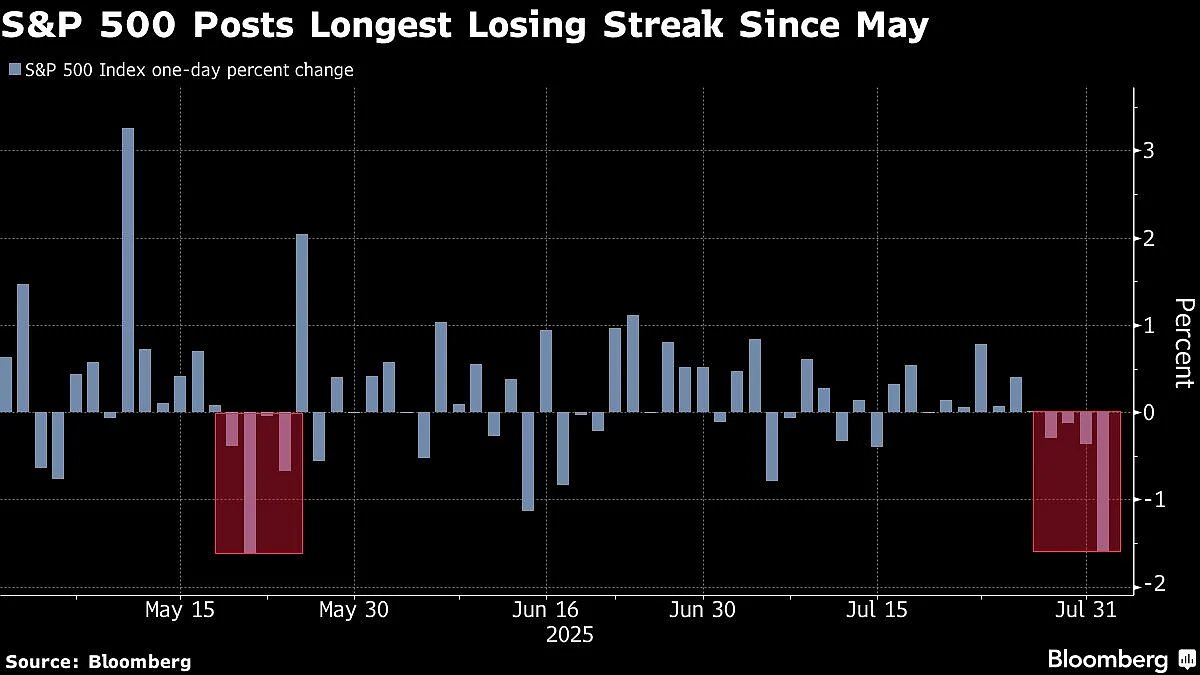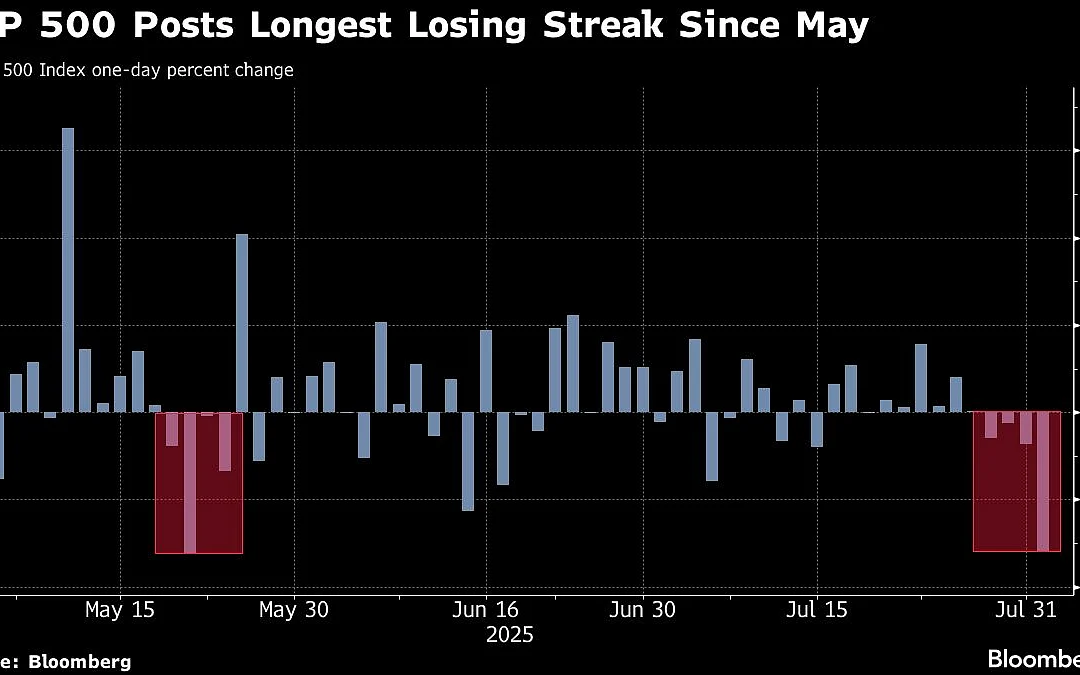US stocks sank Friday in a grim start to August trading after data showed a marked slowdown in job growth and the unemployment rate rose, and President Donald Trump unveiled a slew of new tariffs.
The S&P 500 Index slid 1.6%, extending its retreat into a fourth consecutive day — the longest streak of declines since May. The Nasdaq 100 Index dropped 2% as Amazon.com Inc. plunged following a disappointing earnings readout. Sectors that would be hardest hit by tariffs dropped 1% or more, while defensive consumer staples gained 0.5%. The Cboe VIX Index jumped above 20.
Riskier parts of the stock market were hit even harder: the Russell 2000 Index of small-cap stocks fell 2%, while a gauge of the most-shorted companies declined 3.1%.
Payrolls increased 73,000 in July after the prior two months were revised down by nearly 260,000, according to a Bureau of Labor Statistics report out Friday. In the last three months, employment growth has averaged a paltry 35,000 — the worst since the pandemic. The jobless rate ticked up to 4.2%. The data sent a stronger signal that the labor market is weakening more notably., with job growth cooling substantially and unemployment rising.
“The record highs, expensive valuations in combination with tariffs, the expected uptick in inflation – all make this a great time to sell and re-evaluate come the fall,” said Michael O’Rourke, chief market strategist at Jonestrading Institutional Services LLC. “The market has been very complacent in recent weeks, especially heading into this tariff deadline.”

President Trump said he was directing officials to fire Erika McEntarfer, the commissioner of the Bureau of Labor Statistics, hours after a report showed US job growth cooled sharply over the last three months.
“The US public statistics represent the gold standard,” said Neil Dutta, head of US economic research at Renaissance Macro Research LLC, in an note. “Calling them into question just because they tell you something you don’t like undercuts market confidence.”
Federal Reserve Governors Christopher Waller and Michelle Bowman expressed concerns that policymakers’ hesitance to lower interest rates could risk unnecessary damage to the labor market.
Meanwhile, Trump unleashed a wave of new tariffs that boosted the average US rate on goods from across the world, forging ahead with his turbulent effort to reshape international commerce.
Although the baseline rates for many trading partners remain unchanged at 10% from the duties Trump imposed in April, he raised tariffs on some Canadian goods to 35% and increased rates for countries like Switzerland and New Zealand.
“While overall levels are not flashing red, the trend is cause for concern,” said Alexandra Wilson-Elizondo, co-CIO of multi-asset solutions at Goldman Sachs Asset Management, in an email. “This print is just one number in a week filled with important economic data releases, but the miss directly challenges the Fed’s hawkish posture from this week’s FOMC meeting.”
He also threatened to pile an additional 40% tariff on any product that Washington determines to be “transshipped” through another country, a punishment aimed at stopping goods mainly from China dodging US duties.
Amazon dropped 8.3% on Friday after projecting weaker-than-expected operating income and trailing the sales growth of its cloud rivals, leaving investors searching for signs that the company’s huge investments in artificial intelligence are paying off.
Although Apple Inc. reported its fastest quarterly revenue growth in more than three years after demand picked up for the iPhone and products in China, shares fell alongside the broader market.
The rally that’s propelled the so-called Magnificent Seven stocks 45% higher since April looks stretched, Bank of America Corp. strategists say.
Bullish investors in the cohort of American tech behemoths will need to see fresh highs in key indexes that track these companies in order to keep faith in their stellar performance, the team led by Michael Hartnett said in a report Thursday.
The S&P 500 posted a string of records during July, driven by solid earnings, favorable economic data and signs of progress on the trade front. A key factor in the gauge’s strong performance was a record rally near the tail-end of the month, with the benchmark setting a six-session streak of records before a brief pause.
Yet through the whole month of July, the S&P 500 failed to record a move that exceeded 1% in either direction — the first such occurrence since October — before the streak of anemic swings in the 500-member gauge was broken on Friday.

Wall Street’s smart money has held onto their bearish views. Hedge funds unloaded US equities the past four weeks, as dumping of shares outpaced short-covering, according to a Goldman Sachs Group Inc. prime brokerage desk report.
In other individual company news, Exxon Mobil Corp. and Chevron Corp. posted better-than-expected results after record oil production cushioned the impact of lower crude prices.
Coinbase Global Inc. shares cratered after the largest US crypto exchange reported revenue for the second quarter that missed the average analyst estimate, amid a drop in digital-asset market volatility. Eli Lilly & Co. bounced after the Washington Post reported that the US government plans to experiment with covering weight-loss drugs for federal health programs.
. Read more on Markets by NDTV Profit.

